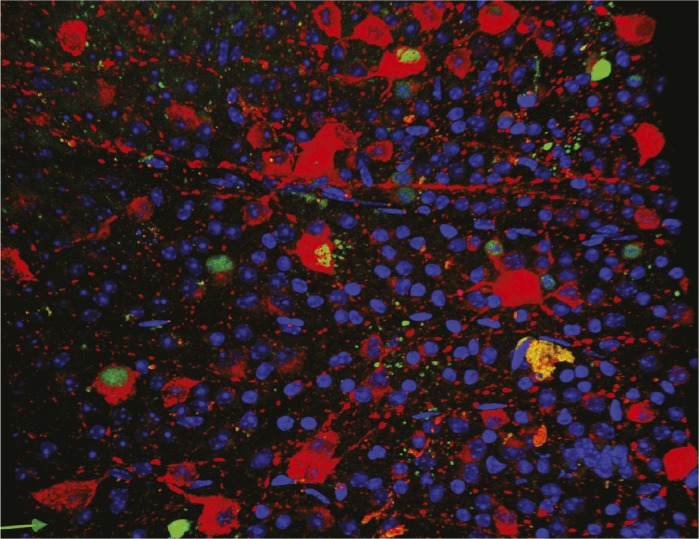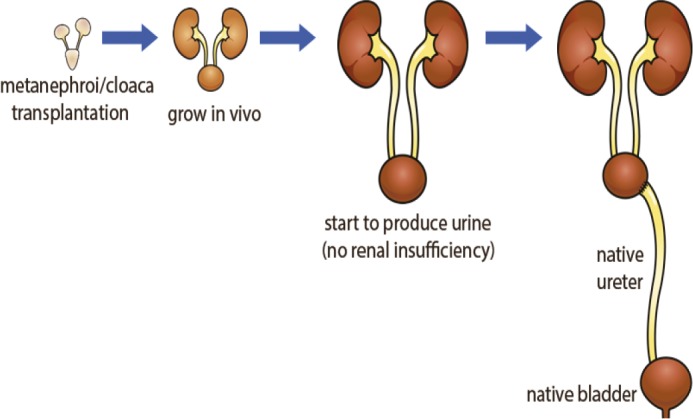Mouse model of mitochondrial DNA mutations

Retinal ganglion cells expressing human NADH ubiquinone oxidoreductase subunit 4 (green) and fluorescent marker Cherry (red), with cell nuclei (blue).
Leber hereditary optic neuropathy (LHON) is a disorder of the retina and optic nerve associated with a mutation in mitochondrial DNA (mtDNA). Developing therapies for disorders caused by mtDNA mutations is challenging because of a lack of suitable animal models. Hong Yu et al. (pp. E5689–E5698) introduced human mtDNA containing the LHON mutation directly into mitochondria of mouse zygotes using a virus. The zygotes developed into transgenic mice that expressed the mutant gene in their optic nerves and retinas. Breeding transgenic females with nontransgenic males for several generations produced more than 200 transgenic mice exhibiting hallmark signs of LHON, including progressive vision loss, thinning of the retina, and severe optic nerve atrophy. Transgenic mice also exhibited increased oxidative stress and decreased cellular respiration in the optic nerve, compared with control mice. The authors were able to partially reverse the vision loss by injecting a virus containing wild-type human mtDNA into the eyes of the transgenic mice. The authors suggest that their method could be adapted to create mouse models of other disorders caused by mtDNA mutations, enabling tests of treatments for such disorders. The results also suggest that gene therapy might be a promising approach to treat such disorders. — B.D.
Antibiotic resistance in tuberculosis bacterium
Tuberculosis is a leading cause of death worldwide, in part because the bacterium responsible for the disease, Mycobacterium tuberculosis (Mtb), is resistant to many commonly used antibiotics. Many such antibiotics inhibit the synthesis of a molecule called peptidoglycan, an essential component of the bacterial cell wall. However, the molecular networks involved in peptidoglycan synthesis in Mtb are poorly understood. Karen Kieser et al. (pp. 13087–13092) used high-throughput sequencing and transposon mutagenesis screens to assess the impact of genome-wide mutations on the growth of Mtb strains lacking enzymes called PonA1, PonA2, or LdtB, which play a major role in peptidoglycan synthesis. The authors found that either PonA1 or PonA2 was required for cell growth, but PonA1, PonA2, and LdtB interacted with largely distinct networks of enzymes to support peptidoglycan synthesis. Moreover, different antibiotics that inhibit cell wall synthesis had different effects on the survival of Mtb strains lacking PonA1, PonA2, or LdtB. Together, the findings reveal that Mtb uses distinct cell wall synthesis pathways that may contribute in different ways to antibiotic resistance. According to the authors, different antibiotics could potentially synergize with each other to produce strong effects against drug-resistant Mtb strains. — J.W.
King crab habitat range

King crab. Image courtesy of Allison Randolph.
King crabs and other predators that can crush the exoskeletons of their prey have been excluded from the shallow habitats of the Antarctic continental shelf by cold water temperatures. Richard Aronson et al. (pp. 12997–13002) observed king crab specimens on the continental slope of the Antarctic continent at depths between 841 and 2266 m, with evidence of an average reproducing population of 4.5 individuals per 1,000 m2 on the slope. At the time of the 2010–2011 survey, the authors note, water temperatures on the outer continental shelf presented no thermal barrier to migration of king crabs up to the continental shelf, around 400–550 m. Cold surface water presented a barrier to migration to coastal areas, but echinoderms, such as sea urchins, and mollusks were abundant on the outer continental shelf and would serve as prey for king crabs if the crabs were to emerge onto the continental shelf. The results suggest that warming waters may allow king crabs and other shell-crushing predators to expand their habitat range, and that the presence of such predators may reshape food webs in affected ecosystems, according to the authors. — P.G.
Estimating extinction rates of reptiles and amphibians
Despite efforts to estimate the extinction rates of various major species, accurate tallies have proven difficult to achieve. John Alroy (pp. 13003–13008) used a Bayesian statistical method to estimate the number of extinct amphibian and reptile species around the world. The method used data from amphibian and reptile museum specimen records and published observations from nine major geographical areas to compute extinction probabilities. Although the counts are conservative, they indicate that extinctions have been steadily accumulating for the last 3 or 4 decades, with at least 194 frog species already extinct worldwide. Frog extinctions were particularly high in Latin America, possibly due to the pathogenic chytrid fungus Batrachochytrium dendrobatidis. The author found that current extinction rates have increased greatly and are now four orders of magnitude higher than the long-term background average. According to the author, hundreds more frog species may become extinct within the next century even without factoring in other environmental threats, potentially resulting in a global mass extinction of frogs. The author suggests that the extent of the mass extinction will remain unclear without intensive sampling of different species, particularly in the tropics. — S.R.
Urine excretion from stem cell-derived kidneys

SWPU system for urine excretion in stem cell-generated kidneys.
The number of patients with end-stage renal disease is increasing worldwide due to a shortage of donor organs. Researchers have recently succeeded in growing functional kidneys from human stem cells, but these kidneys are unable to grow to full size due to a lack of a pathway for excreting urine, resulting in a condition called hydronephrosis. Shinya Yokote et al. (pp. 12980–12985) developed a potential solution by implanting embryonic rat kidneys with bladders into adult rat hosts. Four weeks after transplantation, the authors connected one of the host rat’s ureters to the transplanted bladder. The intervention allowed the urine from the transplanted kidneys to pass first into the transplanted bladder and then into the host bladder, thereby avoiding hydronephrosis. Eight weeks after transplantation, the kidney tissues contained structures characteristic of mature kidneys. To examine the clinical feasibility of this system, called the stepwise peristaltic ureter (SWPU) system, the authors repeated the experiments using pigs and achieved results similar to those observed in rats. By providing a urine excretion pathway and allowing long-term growth of newly generated kidneys, the SWPU system might potentially help overcome challenges in generating functional kidneys from stem cells. — B.D.
Exploring runner’s high in mice

Mouse on a running wheel.
Running is known to boost blood levels of β-endorphins, previously associated with subjective feelings of well-being often characterized as “runner’s high.” Because endorphins are too large to cross the blood–brain barrier, Johannes Fuss et al. (pp. 13105–13108) attempted to determine whether other molecules might play a role in aspects of the feeling experienced by runners. Compared with mice that were not allowed to run, mice that ran approximately 6.5 km on a running wheel for around 5 hours shortly before behavioral tests displayed reduced signs of anxiety and heat-induced pain sensitivity, and were less active when exposed to the wheel after the tests. Mice that ran had higher plasma levels of the endocannabinoid compound anandamide, previously linked with running, than mice that did not run; running was not associated with changes in anandamide levels in cerebrospinal fluid and several brain regions. Drugs that blocked brain endocannabinoid receptors appeared to inhibit the beneficial effect of running on anxiety and pain sensitivity; no such inhibition was observed with a drug that blocked endorphin signaling. Mice lacking the endocannabinoid receptor CB1 in a subset of neurons in the forebrain failed to show the reduction in anxiety associated with running. According to the authors, endocannabinoids might mediate aspects of runner’s high via cannabinoid receptors in mice. — P.N.


